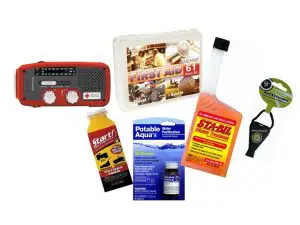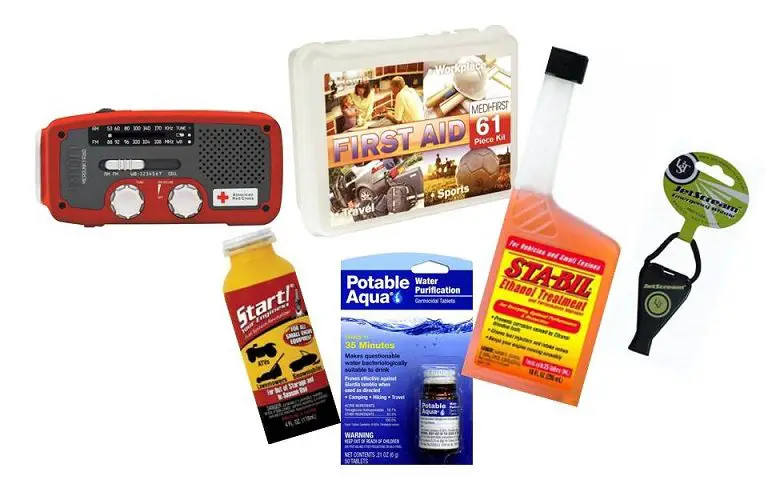
Although we’re in the midst of summer and storms are not foremost in our minds right now, storm and tornado season is in full swing. Each year, the United States gets an average of 5.9 hurricanes, 1,000 tornadoes and 10,000 severe thunderstorms. Storms can be as scary as they are unpredictable and cause immense damage. But, rather than fear the unknown, it is best to put worries aside and be prepared. The following are some important steps for ensuring you have the tools to brave potential storms.
Before the storm
Listen to the news and local forecasts to give yourself as much notice as possible
Secure a back-up generator, such as a Generac portable generator, and place it off the floor in case you experience flooding.
Make sure your generator is in working order by checking the oil and adding fresh fuel with a bottle of STA-BIL Ethanol Treatment to keep the fuel fresh and combat damage from ethanol in today’s gasoline.
Run the generator for a few minutes. If the generator does not start, add a bottle of Start Your Engines! Fuel Revitalizer to clean the fuel injectors, carburetor and intake valves and get the engine up and running quickly
Create a storm kit of must-have items, such as a battery operated radio, flashlights, batteries, candles, matches, bottled water, blankets, non-perishable food, can opener, first aid kit, list of phone numbers, prescription medications and games to pass the time
When a storm is on its way
- Listen to the news to keep updated on the storm’s status
- Obey evacuation directions in dire situations
- Make sure your cell phone is charged and keep a charger with you
- Set your refrigerator and freezer controls to the coldest settings to keep food longer should the power go out
- Fill your car’s gas tank just in case you need to drive to safety
- Take out a reasonable amount of cash in case ATMs are out of order
- Tie down any large objects outdoors that may get thrown during a storm (e.g. patio furniture, toys) and place valuables inside in a safe place off the floor
- Ensure a supply of water for sanitary purposes by filling your bathtub, sinks and other large containers with water
When a storm is in progress
- Stay indoors and away from windows or glass doors
- Take refuge in a small interior room or closet or below ground if possible
- Listen to the news for updates and directions on how to proceed
I regularly receive emails and comments inquiring about prolonging the life of gasoline for storage. Here is some information About STA-BIL from the manufacturer:
STA-BIL® is America’s #1 selling fuel stabilizer. Stored fuel can go bad in as little as 30 days causing gum, varnish and corrosion to build up in the fuel lines and engine. STA-BIL brand products help keep fuel fresh and protect engines from corrosion, while cleaning fuel injectors, carburetors and intake valves to ensure your equipment from generators to chainsaws, leaf blowers and more are in working order when you need them most. Visit Sta-Bil.com.


I had begun prepping just a few weeks ago, being on a very limited budget. Most of my gathering in of supplies were food and medical. The flash floods of this week, declaring our city a disaster area, were a nudge to prioritize, even though it didn’t directly affect our family. I will step it up this month.
there aren’t a lot of storms where I live, so it’s easy to forget about preparation and safety here.
every couple of years, we get monsoon rains, and inevitably, a bunch of people damage their cars by trying to drive through flooded intersections.
if you’re evacuating, please leave as early as possible to allow time for finding alternate routes when you come across obstacles, and never drive into water if you can’t see the ground.
I prefer to rotate 5-gallon gasoline cans into my car and use STA-BIL for larger containers that I don’t have access to as often.
Before a major storm hits, I like to prepare my kids for the possibility that the lights might go out and other things that may scare them. They each have flashlights of their own and they will often set them near where they are playing, or place them close to their beds at night when bad weather and its potential hazards are predicted.
Pray and ask God for wisdom and grace to make smart decisions. Make sure you breath and stay calm. Pay attention and think through your preperations. It doesn’t matter if anyone else prepares, you must prepare. Keep in mind, “it is better to have it and not need it then to need it and not have it.” Communicate well with your family what the preps are and what the escape plan will be if necessary.
When you have done all you can try to relax, thank God for helping you and being with you. Then be courageous becasue you are as ready as you can be.
“May the God of hope fill you with all joy and peace in believing, so that by the power of the Holy Spirit you may abound in hope.” (Romans 15:13 English Standard Version)
I second Bill, pray! And as MIchelle said, prepare the kids. If it’s not dangerous and the lights go out, we have a “campout” in the living room. The kids think its cool and its fun.
All: It’s not just young kids that need to be given the heads up, it’s college students and young adults as well! Prior to Hurricane Sandy hitting last fall, I spent a ton of time e-mailing and calling my son, encouraging him to stock up on food, water, etc. He now has a BOB for both his apt at school and his car.
If you are in the path of a tornado, seek shelter immediately, underground if possible. THEN call someone outside of the area you are in and tell them where you are hiding. Be very specific about your location. If you are unable to contact someone, post your location on Twitter or Facebook. Just telling someone your pre-disaster plans is never enough. When a tornado hits, you may be nowhere near your planned shelter. if a tornado hits your area directly, it may be very difficult, if not impossible, for rescuers to find you right away if your shelter is covered with debris. If you’ve notified others as to your exact location, they can follow up with authorities to make sure you are rescued quickly
While I’m getting the last minute things together, I pray.
Tips:
1. Keep several milk jugs or 2 liter bottles of soda frozen. We have 2 freezers so this is possible for us.
2.If you lose power, consolidate cold things into one location and don’t open it any more than necessary.
2. Locate the old rotary dial phone we have in the cabinet and make sure it is operational. — If power goes out, the lines still have power for a while. At least until their battery backup fails.
In addition to having food, water, fully charged cell. If there is time to prepare cloths should be washed. In addition, copies of important information; credit cards, deeds, insurance papers should be with a go bag in case of evacuation.
Make sure you have at least a two week supply of food, water and batteries in your storm shelter. Also a hand crank radio, first aid kit and my favorite a weapon for protection. I say two weeks at least for search and rescue crews could be slowed down due to location and hazards.
When tornadoes are in the mix, the old adage of taking reference in the south west corner of the basement is what we did. Something about the general weather pattern for south west to north east.
after having been thru several storms, we have not only a bug out bag for everyone in the family, but we also have some toys ( to keep the kid entertained), important documents and xtra supplies in our shelter area
Your list was pretty complete. I make sure that I have the basics to get me through: water, food, flashlight and radio with spare batteries, candles and matches, extra blankets. One important thing that I’ve learned is to know exactly where these things are before something happens. And I never let my gas tank fall below 1/2 tank.
The “Storm Preparation and Giveaway | The Apartment Prepper's Blog” is actually extremely interesting on https://apartmentprepper.com. The pipes are corroded. The end broke off the drain pipe because I became trying to remove the j-trap. The decorative piece against the wall will not budge so I can’t see at the rear of it.
I am originally from Oklahoma and learned all about the dangers of tornadoes and all the destruction they can cause in a heartbeat. But being the outdoor lover and cook I set out of a new adventure to work in Yellowstone park as a cook for a few years then moved to Montana in off season then there totality when I started my family and had to relearn storm readyness from rain and tornadoes to blizzards and subzero temps and always on the look out for new information on beating the odds when a storm trys to get the best of you
Park your car/truck/vehicle somewhere smart. We don’t get hurricanes or tornadoes where I am, but windstorms have caused many vehicles to be smashed by a tree or a falling branch.
I don’t have a weather radio yet, thankfully we get alerts on our phones. Whenever we have a tornado warning or severe storm warning I do the following:
Check flash light batteries
Make sure cars are full of gas
Have shoes next to the bed
Bags are in the basement
Make sure phones are charged
Close curtains, in case of broken window
Make sure dog goes out before it hits
Food, water,candles are downstairs so I don’t have to worry.
Plan on not driving! Make sure everyone is at home and you got all your goods in the house before the storm hits, this is not hard to do if you pay attention.
I have been in hurricanes, tornadoes, blizzards, ice storms and seen rock slides and mud slides. In each situation people get hurt or die because they tried to drive. Get home and stay home!
Best storm preparation tips. Having things “caught” up to some degree. Laundry and dishes don’t pile up, water on hand, etc. Having some easy to prepare foods in the house all the time.
There are so many issues to address in order to be adequately prepared for the many possible difficult scenarios that might come our way. Let me add one tip that gets less attention than most of the others. Preparing for the return to normalcy of society. Unless the end is truly upon us some semblance of authority will return to try and reestablish order. My tip is to have hard copies or originals of all documents that prove ownership of your property and assets. That means everything. We might not be able to rely on computer records of such things as financial assets or items that the neighbors borrowed while we were safely riding out the storm at our bug out location.